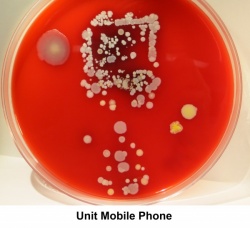Yuck factor may boost hand hygiene compliance
The yuck factor may be an effective tool for boosting hand hygiene compliance among health care workers, according to a study at Henry Ford Hospital in Detroit.


Infection Prevention and Control specialists observed that showing magnified images of bacteria found on things common in the health care environment like a mouse pad or work station, even a person’s hand, swayed workers in four patient care units to do a better job of cleaning their hands. Compliance rates improved on average by nearly 24 percent.
Ashley Gregory and Eman Chami, Henry Ford Infection Prevention and Control specialists and study co-authors, say they both were surprised by the results. “These images put a face to the continuous hand hygiene education that health care workers get,” Gregory says. “They stick in your mind.”
“They gross you out,” Chami says of the images, “and they really magnify what people can’t see.”
It’s estimated that health care workers practice proper hand hygiene less than half of the time they should, according to the Centers for Disease Control and Prevention. The CDC says health care workers might need to clean their hands as many as 100 times per 12-hour shift, depending on the number of patients and acuity of care.
Like other hospitals across the country, Henry Ford integrates hand hygiene into routine, day-to-day practice and utilizes ongoing education to remind health care workers of the importance of cleaning their hands before and after patient interactions. Henry Ford has a 70 percent hand hygiene compliance rate.
For their study, Gregory and Chami sought to evaluate whether the yuck factor of bacteria could affect hand hygiene compliance in four units with low compliance rates between July and September 2015. They visited each unit 10 times and swabbed various items for bacteria, including people’s hands, using an adenosine triphosphate meter. During each visit, workers would be shown images from a compilation of 12 magnified images of bacteria to demonstrate what it would like it under a microscope. Compliance rates were tested at the mid-point and once all visits were completed.
Compliance rates increased 22.9 percent, 36 percent, 142 percent and 37.6 percent, respectively on each of the units.
“I think health care workers in general become numb to the fact that hospitals are an environment of germs,” Gregory says. “We believe our study demonstrates that pictures go a long way to breaking that detachment, and gives hospitals a new tool for their hand hygiene toolkit.”
Source: Henry Ford Health System
27.06.2016











